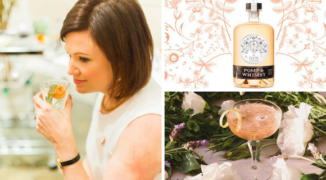Genever (juh-NEE-ver or ye-NAY-ver) has a long, misunderstood history. It dates back to the 16th-century Netherlands with the first written record in 1552 of a malted wine flavored with juniper. Its palate has been described as similar to a light Scotch or grassy single malt-grain-forward, bold, sometimes hot. And, for frustrated advocates and distillers of the spirit, unfairly lumped in with gin for far too long.
Genever is the antecedent of gin — its great (6x) granddaddy. By European Union law, it can only be made in the Netherlands and Belgium and a few regions in France and Germany. Up until the end of the 19th century, genever was produced using a pot still, flavored with juniper and then either bottled or barreled. Modern genevers are produced on a column still giving the distiller the ability to blend malt-wine with the neutral grain spirit along with a few botanicals and of course, juniper. But the key is malt-wine. Even modern genevers like Dutch distillery Rutte’s Old Simon retain the grain-forward qualities of their forefathers, despite using what many would consider atypical botanicals for the ancient spirit.
“The Old Simon is an old family recipe. We didn’t need to modernize it. It is very suitable for the 21st century as it is not a 100% malt-wine genever like those from the 18th century,” Myriam Hendrickx, Rutte’s master distiller, says of their decision to produce a “modern” genever.
She goes on to explain Old Simon’s unique yet traditional genever qualities, “We find that lots of malt wine (think young whisky) tastes nice when it is aged, but unaged it’s kind of heavy. The Old Simon has half malt-wine, half neutral grain spirit and it’s then surrounded by 12 botanicals, including fresh berries from the Dutch sea coast and the most important feature: roasted hazelnuts and walnuts.”
Hendrickx believes genever is and should be considered a separate category from gin.
There’s been a recent push to recognize genever as its own category with some advocates insisting bartenders place it closer to the whiskies and Scotch rather than the gins and vodkas on the back bar.
In the American market, genever is relatively unknown. For bartenders who so often play the role of the consumer educator, explaining the differences between it and gin can be tricky. Sadly, this conundrum leads to perfectly lovely genevers collecting dust on the shelves and the call for its use in cocktails, especially classics, left unanswered.
But, there’s hope for genever yet. You have only to look toward the godfather of cocktails, Jerry Thomas.
Introducing genever to guests is all about looking into our cocktail past. According to spirits historian David Wondrich, when Mr. Thomas called for “Hollands” in his cocktails, he was most likely referring to genevers. Yes, genevers were actually some of our first “gin” cocktails despite the rise and eventual domination of London Dry.
But where did genever go, and why hasn’t it regained the traction it once had in America, whose lust for whiskey seems ripe for a genever takeover?
“The quickest way to bring up genever sales is for bars to stop automatically grouping it in with gin. It is essentially a juniper-infused whisky,” Sipsmith’s master distiller, Jared Brown says. “Once that flavor profile is understood and embraced, the old recipes calling for ‘hollands’ or ‘geneva’ make much more sense. It is a beautiful and overlooked category.”
Like Brown and Hendrickx, The Gin Foundry’s Olivier Ward also feels genever deserves its own spirit category, “Genever is unique in its own right and offers up such a massive array of options that it’s really not fair to compare it to being ‘yet another gin.’ Yes, it is indeed gin’s forefather and yes, juniper is in both, however, in my opinion, genever is to gin what Scotch is to bourbon. You can’t introduce it as the same thing.”
So, how do you introduce it?
Whitechapel’s “ginneseur” Keli Rivers offers this advice to bartenders when suggesting genever cocktails to guests, “When you think of genever as the missing link between whiskey and gin, the possibilities of switching it out with whiskey are endless. I keep in mind that most whiskey has been aged and try to balance out some of those missing notes with bitters and even a barspoon of gomme or other modifiers.”
She believes guests and bartenders both need to understand the category better which means bartenders have to experiment with genever in recipes and consult Jerry Thomas’ “How To Mix Drinks” for inspiration and historic context.
Ward says during the era of Jerry Thomas, “Hollands” were not uncommon cocktail orders or recipes in books. Genever was being imported into the United States at a rate of nearly 4-to-1 compared to London Dry which lends further credibility to the theory genever was the original spirit in some of our most classic gin cocktails.
In the research Wondrich has done on the history of genever in the United States, he found around 1850, the port of New York was clearing between 4,500-6,000, 120-gallon pipes of genever compared to the 10-20 of English gin.
A number of factors lead to genever’s American demise beginning in the 1880s. Cognac supplies were depleted by the pesky Phylloxera bug leading to rye whiskey’s dominance in cocktails. Genever was now competing against a similar, more accessible spirit. But it was the importation of vermouth which struck the fatal blow as it paired beautifully with lighter spirits like gin and helped bring about the classic dry martini.
With gin’s recent renaissance in the United States, genever distillers such as Rutte, Bols, Diep and Boomsma are helping to educate the industry on the aged spirit through master classes, seminars like “Juniper Ascending” at this year’s Tales of the Cocktail and brand education leading to genever’s rightful place once again in cocktails.
Genever cocktails to consider
Olivier Ward recommends playing with different genevers in a Manhattan. Jared Brown agrees, having served the discerning Gary Regan a Manhattan concocted with Bokma 5 Year genever. Regan responded by ordering two more.
Keli Rivers says a Tom Collins with Bols is surprising — taking the drink from thin and citrusy to a complex cocktail with depth and body. She and Myriam Hendrickx both recommend subbing out the Old Tom in a Martinez with genever or to make a Holland Cocktail (a Dutch Old Fashioned). These are great genever gateway cocktails for whiskey drinkers.
Ready to give genever an overdue try? Test out Keli Rivers’ Improved Holland Cocktail.





